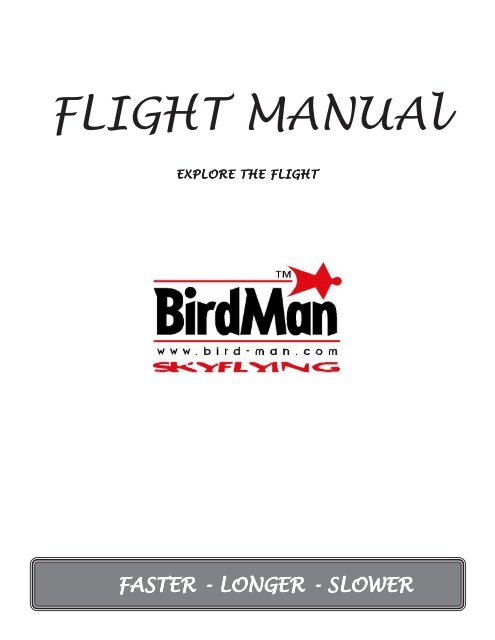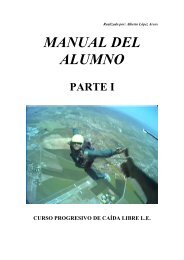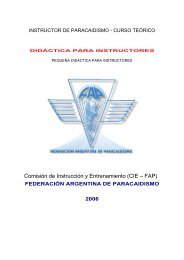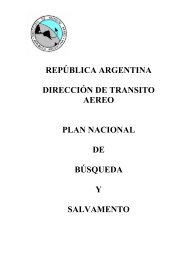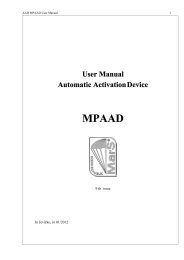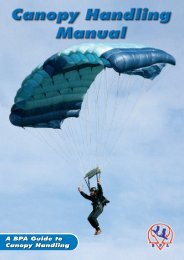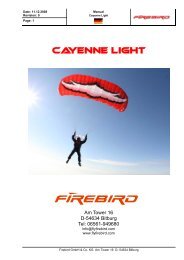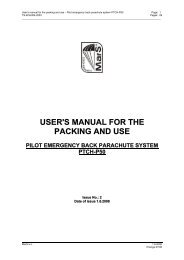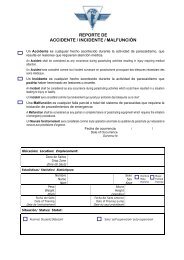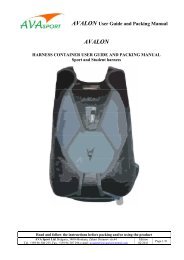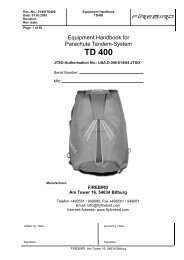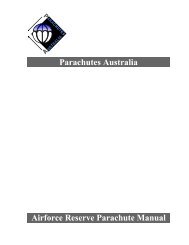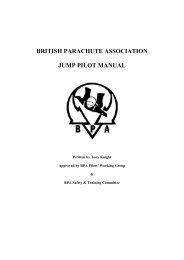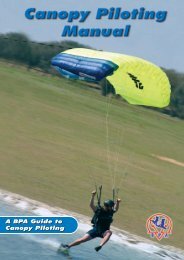You also want an ePaper? Increase the reach of your titles
YUMPU automatically turns print PDFs into web optimized ePapers that Google loves.
FLIGHT MANUAl<br />
EXPLORE THE FLIGHT<br />
FASTER - LONGER - SLOWER
EXPLORE THE FLIGHT<br />
BIRDMAN SUIT • THE FLIGHT MANUAL<br />
AL<br />
W A R N I N G<br />
! !<br />
Skydiving and wing flying are high-risk activities which may cause or result in serious injury or death.<br />
DO NOT attempt to land a wing suit without a fully inflated parachute.<br />
BThe following information must be read and understood before any use of this equipment.<br />
IRD AN<br />
User knows the risks of skydiving and accepts that:<br />
➤ Skydiving causes deaths and serious injuries. Many of these deaths and injuries can be attributed to equipment<br />
malfunctions.<br />
➤<br />
➤<br />
Skydiving equipment can fail, even if the user takes all possible precautions.<br />
M<br />
Failure to activate the main or reserve parachute (or to apply emergency procedures) at a safe altitude,<br />
and/or equipment failures can result in severe injury or death.<br />
It is the user‘s responsibility to:<br />
➤ Receive proper training before any use of all skydiving equipment.<br />
➤ Be extremely careful and cautious.<br />
➤ Read and understand all owner’s and operations <strong>manual</strong>s for all skydiving equipment.<br />
➤ Check all skydiving equipment and replace any defective or worn component prior to use.<br />
➤ Review emergency procedures before each use of this and all skydiving equipment.<br />
➤ Check equipment warnings - do not exceed equipment limitations.<br />
➤ Never violate the training and experience requirements for the specific equipment in use.<br />
Disclaimer<br />
Because of the unavoidable dangers involved in the use of this and all parachute equipment, BirdMan Interna<br />
tional Ltd and BirdMan Inc. (including, but not limited to, all owners, officers, staff and employees) makes no<br />
warranties of any kind, expressed or implied. It is sold with all faults and without any warranty of fitness for any<br />
purpose. By using this equipment or allowing it to be used by others, owner/buyer waives any liability of BirdMan<br />
International Ltd and BirdMan Inc. for personal injuries, death or damages from such use. Any promises or representations<br />
inconsistent with, or in addition to, this statement of warranty are not authorized by BirdMan International<br />
Ltd and BirdMan Inc. and shall be not binding.<br />
If any customer of BirdMan suit declines to waive liability on the part of the manufacturer or authorized BirdMan<br />
dealer, the customer may have a full refund of the purchase price by returning the wing suit before it is used.<br />
Return the suit to the manufacturer or authorized dealer within 21 days from the original date of purchase.<br />
! !<br />
This <strong>manual</strong> is not a course of instruction on how to make a parachute jump, fly a wing suit, nor does it contain<br />
regulations that govern sport parachuting and related activities.<br />
page 2<br />
BirdMan Inc. • 1665 N. Lexington Avenue, Suite 103 • DeLand • 32724 • Florida • USA<br />
Tel:+1 386 785 0800 • Fax:+1 386 785 0080<br />
Email: info@bird-man.com • Web: www.bird-man.com
EXPLORE THE FLIGHT<br />
Prologue<br />
Man has always dreamt of flying – now he can. Imagine soaring through the bright blue sky flying forward at<br />
130km/h (80mph) but descending at only 70km/h (40mph). You feel the wind in your face, it is quiet and it<br />
makes you feel like a bird. You and your friends fly in formation – banking and chasing.<br />
Together you accelerate your speed and fly around a puffy white cloud. You have been flying for more than two<br />
minutes so it’s time to wave off to your friends and open your parachute.<br />
Histor<br />
B IRD AN<br />
istory<br />
Ever since they realized that freefall does not kill, parachutists have always wanted to exceed their limits in this<br />
beautiful and exotic environment. Brave men and women were pushing their limits, and unfortunately sometimes<br />
pushed them too far in order to achieve the dream of human flight. From the 1930s to the early 1960s a few<br />
men tried to break their freefall and fly with the help of artificial wings. They were called birdmen. Clem Shohn and<br />
Leo Valentin were two of the most famous, but like most of the early birdmen they gave their lives while doing<br />
what they loved the most. Between 1930 and 1961, 72 out of 75 birdmen died while trying to achieve their dream.<br />
During the mid-90s legendary skydiver Patrick DeGayardon made his own innovative wing suit. With his suit Patrick<br />
was able to fly like no one had ever imagined – not even the original birdmen. Sadly, Patrick died on April 13 th ,<br />
1998 while testing his new wing suit.<br />
M<br />
Though generations change, the dr<br />
Many things have changed since the days of Leo Valentin. Because of constant technological advances, skydiving<br />
equipment is safer than ever. Advances in training are also producing safer and more competent skydivers than in<br />
past years. In general, a modern skydiver knows more about skydiving and freefall after completing an AFF course<br />
than most modern birdmen pioneers ever did. Skydiving has become safer and we are now capable of things that<br />
many in the past had only dreamt of doing.<br />
Though generations change, the dream remains<br />
In the fall of 1998 Jari Kuosma from Finland and Robert Pecnik from Croatia joined forces with a mission to give<br />
life to the old dream of human flight. Their goal was to make safe and functional high performance wing suits<br />
that every reasonably-experienced skydiver could fly and enjoy. After nine prototypes, plenty of mistakes, many<br />
laughs and long flights the first-ever commercially available wing suit was manufactured in June 1999. The BirdMan<br />
suit was named after Leo Valentin (the original birdman), to honor all the skydivers who dared to dream of human<br />
flight.<br />
The Mission<br />
Our mission and dream is to promote safe skyflying and the ultimate feeling of flight itself. We believe that<br />
some day there will be as many bird men and women as in any other skydiving discipline. Skyflying is extremely<br />
fun. It is easy to learn and safe when flown with respect. A whole new world has been opened; the possibilities<br />
are endless. After all, we do have the biggest playground in the world – the sky!<br />
Since the birth of BirdMan, thousands of skydivers have successfully flown with the BirdMan suit.<br />
Jari Kuosma is president of BirdMan. Robert Pecnik is in charge of design and manufacturing. True modern day<br />
pioneers and developers of skyflying, Jari and Robert are the most experienced wingsuit flyers, designers and instructors<br />
in the world. Kim Griffin is the company’s business manager, as well as a BirdMan instructor.<br />
BirdMan Inc. • 1665 N. Lexington Avenue, Suite 103 • DeLand • 32724 • Florida • USA<br />
Tel:+1 386 785 0800 • Fax:+1 386 785 0080<br />
Email: info@bird-man.com • Web: www.bird-man.com<br />
page 3
EXPLORE THE FLIGHT<br />
Requir<br />
equirements ements for flying the Bir<br />
irdM<br />
dMan suit<br />
EXPERIENCE<br />
BirdMan recommends that a person who intends to use the wing suit be an experienced, current and licensed<br />
skydiver. We recommend that such a skydiver have 500 or more freefall skydives before attempting to learn to<br />
fly a BirdMan wing suit on his/her own. We recommend a minimum of 200 jumps within 18 months if a jumper is to<br />
receive one-on-one training from a BirdMan Instructor. He/she should make at least one solo practice/tracking<br />
jump without a wingsuit before making his/her maiden flight with a BirdMan instructor. More important than the<br />
number of skydives is whether the skydiver feels comfortable in freefall, especially in the tracking position, has the<br />
ability to concurrently observe airspace and altitude, and feels confident about his/her ability to perform safely in<br />
this unique type of skydiving.<br />
BPRACTICE<br />
IRD AN<br />
It is necessary to practice exit, flight, pull and emergency techniques on the ground, before you can do your<br />
first flight with the wing suit. You will also need to practice all these skills on your first wing suit flight. It is very<br />
important to read and understand the BirdMan suit flight <strong>manual</strong> before the first flight. It is also as important to<br />
understand the importance of communicating with the pilot and fellow jumpers about your flight plan.<br />
of the large burble behind your back and the fact that the wings restrict the freedom of your arms,<br />
M<br />
EQUIPMENT<br />
Because there are a few things to consider with regards to your equipment.<br />
The main canopy should be relatively docile. Do not use any kind of canopy that you feel uncomfortable or unfamiliar<br />
with. Remember that you need time if you want to free your arms before dealing with a malfunction.<br />
➤<br />
➤<br />
➤<br />
➤<br />
DO NOT use a pull-out pilot chute.<br />
DO NOT use a bungee-type collapsible pilot chute.<br />
DO NOT use a leg strap mounted pilot chute.<br />
Use only a BOC throw-out pilot chute with the wing suit.<br />
Bir<br />
irdM<br />
dMan an suit with AADs and audible altimeters<br />
Because it is possible to achieve very slow vertical speeds with the BirdMan wing suit (averaging just 70 km/h<br />
or 40mph) your AAD will probably not fire your reserve if you are passing through the hard deck (the Expert<br />
Cypress is set up for 36 m/s (about 125 km/h). Also, some audible altimeters may not function properly at slow<br />
vertical airspeeds. For these reasons it is very important to wear a visual altimeter and open at a proper altitude.<br />
Wear your visual altimeter as far away from your body as possible. We recommend wrist-mounted altimeters for<br />
the most accurate reading. BirdMan Inc. strongly recommends using AADs and audible altimeters!<br />
Materials and washing instructions<br />
BirdMan uses two different types of material for the body of any of its wingsuit: AtmoTex or Balloon ZP. Both<br />
fabric types are zero porosity, comfortable, durable and fly equally as well. AtmoTex is heavier for colder climates;<br />
Balloon ZP is lightweight for warmer climates.<br />
The wings on your BirdMan suit are made from Balloon ZP fabric only.<br />
The cutaway cables are made of the same yellow cable used by most rig manufacturers.<br />
To wash your wingsuit, simply remove all cables and throw it into the washing machine. Wash on a gentle cycle<br />
using cold water. Hang the suit to dry; do not put it in the dryer!<br />
page 4<br />
BirdMan Inc. • 1665 N. Lexington Avenue, Suite 103 • DeLand • 32724 • Florida • USA<br />
Tel:+1 386 785 0800 • Fax:+1 386 785 0080<br />
Email: info@bird-man.com • Web: www.bird-man.com
EXPLORE THE FLIGHT<br />
Hooking up your wing suit<br />
➤<br />
➤<br />
➤<br />
Free the cables from your arm wings.<br />
Place your rig on the floor with the back pad facing up. Lay the suit belly up on top of the rig as if<br />
you were actually in the suit and the rig. (The shoulders of the suit should be at the top of the<br />
shoulders on your rig.)<br />
Put the arm wings under the shoulder straps of your rig. Put the leg straps in the holes on the hips of the<br />
suit. (There is no need to undo your leg straps for this.)<br />
Hooking up y<br />
B IRD AN<br />
ooking up your wings<br />
Keep in mind that wingsuit and harness sizes vary greatly. The instructions below likelly apply to your suit,<br />
but use common sense. It is most important that your emergency handles are NOT covered in any way.<br />
1<br />
2<br />
3<br />
4<br />
5<br />
6<br />
7<br />
8<br />
9<br />
FRONT WING (BELLY SIDE) • LEFT AND RIGHT SIDES:<br />
Start by threading the yellow cable through the white tab on the body<br />
M<br />
of the suit. Always start on the body first, not the wing!<br />
Then put the cable through the tab on the wing. Continue to thread<br />
the cable through the tabs in this manner (body tab, wing tab, body<br />
tab, wing tab, body tab, wing tab...etc.)<br />
To leave room for your emergency handles to stick out, do NOT threa<br />
the cable through the WING TAB that is THIRD FROM THE TOP of the<br />
wing. (Top means closest to the shoulder.) See diagram ➠<br />
Run the cable through the next body tab. There should now be two<br />
body tabs done in a row. Always run your cables behind and out of the<br />
way of your emergency handles.<br />
Continue by running the cable through the next tab on the wing, then<br />
through the body tab, etc. until you are finished.<br />
Stow the excess cable in its holder.<br />
BACK WING (BUTT SIDE) • LEFT AND RIGHT SIDES:<br />
Follow steps one and two above.<br />
To leave room for your rig’s horizontal stabilizers, do the same as in<br />
step 3 and step 4. There should now be two body tabs done in a row.<br />
Run the cable behind your horizontal stabilizers. See diagram ➠<br />
On the back wing, more important than how you hook it up is that your<br />
tabs will not come in contact with your rig’s horizontal stabilizers on<br />
opening and while hanging under canopy. (This may weaken the tabs.)<br />
HOOKUP FRONT<br />
Once you have hooked up your wings, put on your suit, secure all straps and<br />
zippers, and have a friend stand behind you and lift your rig to simulate how<br />
you will hang under canopy.<br />
HOOKUP BACK<br />
BirdMan Inc. • 1665 N. Lexington Avenue, Suite 103 • DeLand • 32724 • Florida • USA<br />
Tel:+1 386 785 0800 • Fax:+1 386 785 0080<br />
Email: info@bird-man.com • Web: www.bird-man.com<br />
page 5
EXPLORE THE FLIGHT<br />
Getting it on<br />
With the suit on the ground, slide yourself feet first into your legs straps and through the legs of the suit. Bring the<br />
suit and rig over your shoulders. (You will soon develop a quick and easy technique.)<br />
➤ Tighten your legs straps as if you were in freefall.<br />
➤ Don the booties and close the leg zippers. Secure the zippers with the snaps.<br />
➤ Close the zippers on your chest.<br />
Fasten your chest strap tightly.<br />
➤ Close the arm zippers, locking the zipper catch at the very end of the zipper. Put the thumb cords in<br />
place (around your thumb and OVER your altimeter).<br />
➤<br />
B IRD AN<br />
➤<br />
➤<br />
➤<br />
➤<br />
➤<br />
➤<br />
➤<br />
➤<br />
➤<br />
BEFORE BOARDING THE AIRCRAFT:<br />
Make sure that your wings are correctly assembled and that the cutaway cables are correctly routed.<br />
Ensure that emergency handles are in position and are not hindered or covered.<br />
Fasten your chest strap tightly.<br />
Ensure that your leg straps are fastened and snug inside the suit.<br />
M<br />
Check that the arm zippers and thumb cords are in good condition.<br />
Have someone give you a pin check.<br />
Check that the BOC throw-out pilot chute and handle are in the correct position.<br />
Do some practice pulls before you enter the aircraft to ensure that you can reach your pilot chute,<br />
and to ensure that it is in correct position. To do so, touch your pilot chute handle with your right<br />
hand while bringing your left arm in symmetrically and closing your leg wing.<br />
After your practice pulls, rehearse getting out of your wings. One at a time, open both of your arm<br />
zippers with a controlled, rapid movement. Unzip to the top of your shoulders for full range of<br />
motion. Simulate reaching the risers. Repeat this until you feel comfortable with the procedure.<br />
Prepar<br />
epare e for flight<br />
WEATHER CONDITIONS<br />
Because you can fly long distances with the suit, make sure that the weather conditions allow you to have visual<br />
contact with the ground at all times during your flight. Remember that the same physical laws apply to you as<br />
to any non-powered flyer. You travel longer and faster in relation to the ground when you fly with the wind and the<br />
reverse happens when flying against the wind.<br />
BRIEFING YOUR FELLOW JUMPERS, PILOTS, ETC.<br />
Before entering the aircraft you need to brief your fellow jumpers and the pilot about your wing suit flight.<br />
Because your freefall time can be twice as long as conventional jumpers, it is safest to exit last (even after<br />
tandems). Make sure the jump pilot is informed about your wing suit flight!<br />
FLIGHT PATTERN<br />
Upon exit, fly 90° off the line of flight (perpendicular to it). How long you fly perpendicular to the line of flight<br />
depends on your spot. Keep your eyes on the DZ; when the time is right, turn 90° towards the dz and fly parallel<br />
to the line of flight. Your horizontal speed can exceed 100 mph, so know where you are and know where others<br />
are.<br />
! !<br />
Never fly across or near the line of flight.<br />
Always have a flight plan before you enter the aircraft.<br />
page 6<br />
BirdMan Inc. • 1665 N. Lexington Avenue, Suite 103 • DeLand • 32724 • Florida • USA<br />
Tel:+1 386 785 0800 • Fax:+1 386 785 0080<br />
Email: info@bird-man.com • Web: www.bird-man.com
EXPLORE THE FLIGHT<br />
Bir<br />
irdM<br />
dMan flight techniques<br />
EXITS<br />
For the first flights we strongly suggest that you exit from inside the aircraft, head high and with your chest to<br />
the relative wind (similar to an AFF level 1 exit.) To perform a good poised exit the most important thing is to<br />
have your wings closed (arms tight to your body, legs together) for the first second that you are exposed to the<br />
relative wind. After you have safely cleared the aircraft, spread your wings (both arms and legs, all at the same time,<br />
symmetrically) and start your flight.<br />
! !<br />
It is important to clear the aircraft before spreading your wings.<br />
If you fail to clear the aircraft, you risk having an unstable exit as well as hitting the aircraft<br />
(body or tail) resulting in severe injuries to you and damage to the aircraft.<br />
B IRD<br />
FLIGHT<br />
AN<br />
To way that no strong forces are needed to maintain this profile. You should fly with your arms and legs extended<br />
and spread while still feeling relaxed. You adjust the flight angle by using your torso and hips. For turns simply look<br />
where you want to go, make small movements, as large movements may result in a steep dive or instability. Your<br />
shoulders and back should be rounded and your legs fully extended, similar to a good track position.<br />
obtain maximum lift you should maintain the profile on all three wings. Your wings are designed in such a<br />
M<br />
WAVE-OFF<br />
Since you cannot use your arms to wave off, you have to wave off with your legs. Click your legs together twice,<br />
while watching the airspace around you, so that anyone near you can see your intention to pull.<br />
PULL<br />
The most critical portion of your wingsuit flight is the pull. The huge burble behind you caused by your large<br />
wings and your forward speed could cause a pilot chute hesitation resulting in line twists. An asymmetrical<br />
body position could cause you to become unstable and can also lead to line twists. Since your bag will come off<br />
your back at a 45° angle you should keep your legs FULLY EXTENDED while you pull. While learning to fly the wing<br />
suit start your wave off and pull sequence higher than normal. (We recommend 4500´ to 5000´ to start.)<br />
➤<br />
➤<br />
➤<br />
➤<br />
HERE IS HOW YOUR WAVE OFF AND PULL SEQUENCE SHOULD GO:<br />
Tap your feet three times. On the third tap keep your legs together and arch slightly.<br />
Symmetrically bring both your arms in for the pull. (Your legs should remain straight and closed the<br />
entire time to decrease the burble.)<br />
Throw your pilot chute vigorously and symmetrically in to clean air.<br />
Close your arm wings once you have released your pilot chute (to decrease the burble.)<br />
!<br />
During the pull you should<br />
keep your legs extended (even when you close them),<br />
be symetrical and throw your pilot chute vigorously. !<br />
AFTER THE PULL<br />
Once your canopy has inflated unzip the arm zippers all the way up so that your arms are completely free to<br />
reach the risers and toggles. Once the you have secured the airspace around you, unsnap and unzip your<br />
booties. The leg wing will trail between your legs and leave you free to run on landing.<br />
BirdMan Inc. • 1665 N. Lexington Avenue, Suite 103 • DeLand • 32724 • Florida • USA<br />
Tel:+1 386 785 0800 • Fax:+1 386 785 0080<br />
Email: info@bird-man.com • Web: www.bird-man.com<br />
page 7
EXPLORE THE FLIGHT<br />
Wing cutaway system<br />
The BirdMan wing cutaway system was designed for use as a backup device. Three reasons you may want to cut<br />
your wings away could be:<br />
➤ You are unstable or not comfortable with your flight. (You can cut the wings away in freefall and bring<br />
your arms up into a box position)<br />
➤ You need to get to your risers fast and do not have time to undo the zippers.<br />
➤ You can’t undo a zipper.<br />
To cut away the wings, simply grab the cutaway handles and pull them up towards your head.<br />
BEMERGENCY PROCEDURES:<br />
IRD AN<br />
Know the placement of your emergency handles and KNOW the emergency procedures for the gear that you<br />
are jumping.<br />
! !<br />
If you have a malfunction on your main parachute, perform your normal emergency procedures to<br />
cutaway your main and activate your reserve parachute!<br />
M<br />
Overall, be awar<br />
The suit was designed to allow you freedom to reach and pull both emergency handles without restriction. This<br />
means that you DO NOT need to cut away your wings first before using your emergency handles (and therefore<br />
waste valuable time and altitude). However, to reach the toggles and risers of your reserve parachute you must<br />
either open the zippers on your arms or cut away your wings.<br />
If you are going to cut away a your main parachute and your arm wings are already undone (either unzipped or cut<br />
away), close your leg wing by putting your legs together before operating any of your handles. Having your leg<br />
wing inflated may cause instability and turbulence.<br />
Ov<br />
erall, be aware, e, be safe and have e FUN!<br />
We welcome your questions and comments. Feel free to contact us anytime at the numbers below. We wish you<br />
many long and safe flights.<br />
Blue skies, long soars…<br />
Jari H. Kuosma<br />
President<br />
BirdMan, Inc.<br />
F A S T E R – L O N G E R – S L O W E R<br />
page 8<br />
BirdMan Inc. • 1665 N. Lexington Avenue, Suite 103 • DeLand • 32724 • Florida • USA<br />
Tel:+1 386 785 0800 • Fax:+1 386 785 0080<br />
Email: info@bird-man.com • Web: www.bird-man.com


